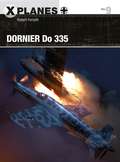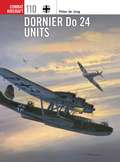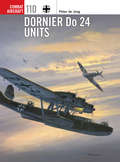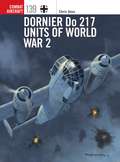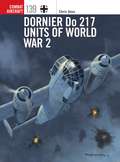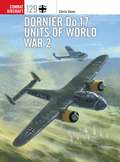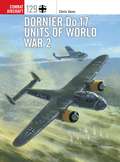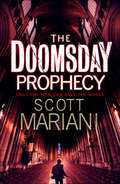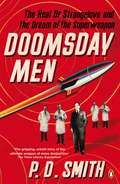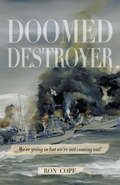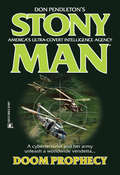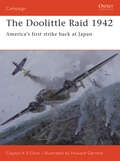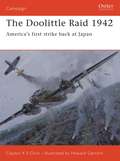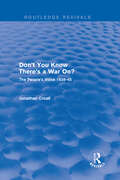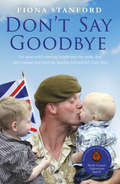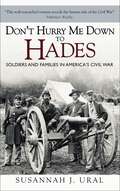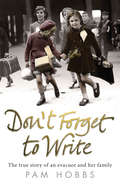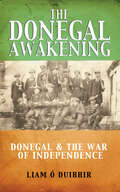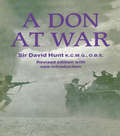- Table View
- List View
Dornier Do 335 (X-Planes)
by Robert Forsyth Adam Tooby Wiek Luijken Simon SchatzThe Dornier Do 335 was conceived as a high-speed, all-weather fighter, and represented the pinnacle of piston-engined aircraft design. The Do 335 was a big aircraft, weighing just over 10,000kg when laden with fuel, equipment, and pilot, yet powered by two Daimler-Benz DB 603 engines, it was capable of reaching a maximum speed of 750km/h at 6400 meters, making it the fastest piston engine aircraft produced in Germany during World War II.Some forty aircraft were built between late 1943 and the end of the war, and it was intended to deploy the type as a day fighter, bomber, night fighter, bad weather interceptor, and reconnaissance aircraft, all of which were intended to incorporate the latest armament, bomb sights, communications, and radar equipment, as well as an ejector seat. Featuring archive photography and specially commissioned artwork, this is the full story of the aircraft that the Luftwaffe hoped would turn the tide of the war.
Dornier Do 335 (X-Planes #9)
by Robert Forsyth Adam Tooby Wiek Luijken Simon SchatzThe Dornier Do 335 was conceived as a high-speed, all-weather fighter, and represented the pinnacle of piston-engined aircraft design. The Do 335 was a big aircraft, weighing just over 10,000kg when laden with fuel, equipment, and pilot, yet powered by two Daimler-Benz DB 603 engines, it was capable of reaching a maximum speed of 750km/h at 6400 meters, making it the fastest piston engine aircraft produced in Germany during World War II.Some forty aircraft were built between late 1943 and the end of the war, and it was intended to deploy the type as a day fighter, bomber, night fighter, bad weather interceptor, and reconnaissance aircraft, all of which were intended to incorporate the latest armament, bomb sights, communications, and radar equipment, as well as an ejector seat. Featuring archive photography and specially commissioned artwork, this is the full story of the aircraft that the Luftwaffe hoped would turn the tide of the war.
Dornier Do 24 Units (Combat Aircraft)
by Chris Davey Mark Postlethwaite Peter De JongPerhaps the most seaworthy flying boat ever built, the elegant, tri-motor Dornier Do 24 served with both the Allied and Axis forces in very different parts of the globe during World War 2, garnering an excellent reputation along the way This study uses archival records, first-hand accounts and revealing photographs to illuminate the combat career of this remarkable aircraft for the first time in English. The German-built Do 24 was the Netherlands Navy's principal aerial asset during the Japanese invasion of the East Indies. While the survivors of that ordeal served in the Australian Air force, in occupied Holland and France production continued apace and the Do 24 equipped the German Air-Sea rescue service, whose crews loved and respected the machine. The type witnessed the rise and fall of the Luftwaffe over all the European seas, took part in the desperate evacuations of Wehrmacht troops on the Baltic in the face of the overwhelming Soviet advance, and was pressed out of service only with the withdrawal of Spanish Do 24s in 1969. This volume tells the long and eventful story of the faithful Do 24 in full.
Dornier Do 24 Units (Combat Aircraft #110)
by Peter De Jong Mr Chris Davey Mr Mark PostlethwaitePerhaps the most seaworthy flying boat ever built, the elegant, tri-motor Dornier Do 24 served with both the Allied and Axis forces in very different parts of the globe during World War 2, garnering an excellent reputation along the way This study uses archival records, first-hand accounts and revealing photographs to illuminate the combat career of this remarkable aircraft for the first time in English. The German-built Do 24 was the Netherlands Navy's principal aerial asset during the Japanese invasion of the East Indies. While the survivors of that ordeal served in the Australian Air force, in occupied Holland and France production continued apace and the Do 24 equipped the German Air-Sea rescue service, whose crews loved and respected the machine. The type witnessed the rise and fall of the Luftwaffe over all the European seas, took part in the desperate evacuations of Wehrmacht troops on the Baltic in the face of the overwhelming Soviet advance, and was pressed out of service only with the withdrawal of Spanish Do 24s in 1969. This volume tells the long and eventful story of the faithful Do 24 in full.
Dornier Do 217 Units of World War 2 (Combat Aircraft)
by Chris GossThe Do 217 had a much larger bomb load capacity and had considerably greater range than the Do 17, which it replaced in frontline service from mid to late 1941. Although initially used simply as a bomber, later variants were developed to allow the Do 217 to undertake the precision maritime strike role. In order to perform the latter mission, the Do 217 was modified to launch glide bombs – units employing these pioneering weapons enjoyed some success in the Mediterranean from the autumn of 1943. During the course of these operations the Do 217 became the first aircraft in military aviation history to deploy a precision-guided bomb in combat in the form of the 'Fritz X' radio-guided, free-fall weapon, which sank the Italian battleship Roma shortly after Italy capitulated in September 1943. The Do 217 served on all fronts, and was often used on anti-shipping strikes during the Battle of the Atlantic and against the Allied invasion fleet at Normandy. This versatile aircraft was also converted into a nightfighter, seeing action in the Defense of the Reich through to war's end.This highly illustrated study explores the design and development of the Do 217 and chronicles its use in the frontline as a strategic bomber, launch platform for first generation precision weapons, reconnaissance aircraft and nightfighter, among others.
Dornier Do 217 Units of World War 2 (Combat Aircraft #139)
by Chris GossThe Do 217 had a much larger bomb load capacity and had considerably greater range than the Do 17, which it replaced in frontline service from mid to late 1941. Although initially used simply as a bomber, later variants were developed to allow the Do 217 to undertake the precision maritime strike role. In order to perform the latter mission, the Do 217 was modified to launch glide bombs – units employing these pioneering weapons enjoyed some success in the Mediterranean from the autumn of 1943. During the course of these operations the Do 217 became the first aircraft in military aviation history to deploy a precision-guided bomb in combat in the form of the 'Fritz X' radio-guided, free-fall weapon, which sank the Italian battleship Roma shortly after Italy capitulated in September 1943. The Do 217 served on all fronts, and was often used on anti-shipping strikes during the Battle of the Atlantic and against the Allied invasion fleet at Normandy. This versatile aircraft was also converted into a nightfighter, seeing action in the Defense of the Reich through to war's end.This highly illustrated study explores the design and development of the Do 217 and chronicles its use in the frontline as a strategic bomber, launch platform for first generation precision weapons, reconnaissance aircraft and nightfighter, among others.
Dornier Do 17 Units of World War 2 (Combat Aircraft)
by Chris GossInitially designed as a high-speed mail aeroplane and airliner, the Do 17 first made an appearance as a military aircraft in the Spanish Civil War, both as a bomber and in reconnaissance roles. In the early stages of World War II, it, together with the Heinkel He 111, formed the backbone of the German bomber arm over Poland, France, Belgium and the Low Countries, and saw action in almost every major campaign in this period. However, by the start of the Battle of Britain, the Do 17's limited range and small bomb load meant that it was ripe for replacement by the Ju 88. Though it performed well at lower altitudes, the model suffered heavy losses during raids, particularly during the Blitz and were increasingly phased out. This fully illustrated study uses detailed full-colour artwork and authoritative text from an expert author to tell the full operation story of one of Nazi Germany's best light bombers from the early years of World War II.
Dornier Do 17 Units of World War 2 (Combat Aircraft #129)
by Chris GossInitially designed as a high-speed mail aeroplane and airliner, the Do 17 first made an appearance as a military aircraft in the Spanish Civil War, both as a bomber and in reconnaissance roles. In the early stages of World War II, it, together with the Heinkel He 111, formed the backbone of the German bomber arm over Poland, France, Belgium and the Low Countries, and saw action in almost every major campaign in this period. However, by the start of the Battle of Britain, the Do 17's limited range and small bomb load meant that it was ripe for replacement by the Ju 88. Though it performed well at lower altitudes, the model suffered heavy losses during raids, particularly during the Blitz and were increasingly phased out. This fully illustrated study uses detailed full-colour artwork and authoritative text from an expert author to tell the full operation story of one of Nazi Germany's best light bombers from the early years of World War II.
The Doomsday Prophecy (Ben Hope #3)
by Scott MarianiFROM THE #1 BESTSELLING AUTHOR ‘Deadly conspiracies, bone-crunching action and a tormented hero with a heart . . . packs a real punch’ Andy McDermott
Doomsday Men: The Real Dr Strangelove and the Dream of the Superweapon
by P. D. SmithIt was the weapon to end all weapons: the doomsday device. A huge nuclear bomb so powerful that it could envelop the entire planet in a cloud of radioactive dust, and bring about instant extinction. This is the untold story of the Cold War’s most insane plan, the men behind it and how it nearly happened. It is also the history of humanity’s nightmare vision of a superweapon, showing how popular culture, from the stories of H. G. Wells and Jules Verne to films such as Planet of the Apes, Mad Max and Dr Strangelove itself have both shaped and reflected our darkest dreams.
Doomed Destroyer
by Ron CopeOn March 1st 1940, Adolf Hitler ordered Operation Weserubung: the invasion of Norway. Having swept across Europe, the Nazi assault on Scandinavia was designed to secure the valuable iron ore being delivered by rail from Sweden to the Norwegian port of Narvik. To complete the task, Hitler sent ten large destroyers, with 220 Alpine Troops on each. Five smaller British H Class destroyers were sent up the fjord in retaliation, with little knowledge of what to expect. On April 10th , the first British battle of Narvik began in earnest. Royal Naval Captain Bernard Warburton-Lee led his flotilla at midnight into the fjord; undetected, under darkness and in driving snow storms. The harbour erupted into a torpedo attack; back into the fjord, the destroyers Hardy, Hunter, Hotspur, Havock and Hostilewere confronted by five German destroyers. A ferocious sea battle ensued and Hardy and Hunter were lost. In his first account of The Battle of Narvick, Attack at Dawn, Ron Cope focussed on the experience and the survival of the crew of HMS Hardy. After nine long years of research, he now reveals for the first time the untold story of HMS Hunter and her crew. Just forty-eight of the 159 servicemen on board survived in the cold waters of the fjord; picked up by German destroyers, they were eventually forced to march in freezing conditions over the mountains into internment in Sweden. Before the handover to the Swedish authorities, a German Army officer made the British servicemen sign a form: "On my being sent into Sweden I will not take up arms against Germany… Should I do so, and in the event of again being taken prisoner I shall be subject to such conditions as are provided under the Death Penalty Act”. Doomed Destroyer follows the astounding stories of the Hunter sailors, who would spend the next five years plotting and attempting to escape their captivity. Cope provides an extensive account of the viciously fought events at sea and in the fjords, examining the Norwegian price paid at Narvik and the early impact of war on the local community’s simple way of life. A remarkable account delivered with care and respect for those lost and left behind, Doomed Destroyer shines a light on this important but previously little known event in British history. “Without dedicated men like Ron Cope, the testimony and the stories of the men who were there – whether they were lost, wounded, or survived – what became of them, their families, might otherwise be lost to future generations.” Percy C. Danby, Lieutenant (E), C.D. RCN Retired. Ottawa. March 2017, survivor on HMS Hotspur.
Doom Prophecy
by Don PendletonThe men and women of the covert defence team Stony Man were handpicked because they believe in a cause, driven by a passion that sends them into daily battle against impossible odds. The computer wizardry of the agency's cybernetics team enables the two action units to strike multiple blows for justice against the world's predators.
The Doolittle Raid 1942: America’s first strike back at Japan (Campaign #156)
by Clayton K. ChunIn early 1942, the strategic situation was bleak for the United States. She had been in continual retreat since Pearl Harbor, surrendering major areas such as the Philippines, and was preparing for the worst in Hawaii and on the West Coast. The Japanese, on the other hand, had secured a well-defended perimeter, and was set for further expansion. Something needed to happen quickly and be of considerable impact-and the combined-arms, April 1942 Doolittle Raid on Japan was a way to achieve this. This book examines the planning, execution, and aftermath of this innovative, daring and risky attack, which would show that the Japanese navy and air forces were anything but invincible.
The Doolittle Raid 1942: America’s first strike back at Japan (Campaign)
by Howard Gerrard Clayton ChunIn early 1942, the strategic situation was bleak for the United States. She had been in continual retreat since Pearl Harbor, surrendering major areas such as the Philippines, and was preparing for the worst in Hawaii and on the West Coast. The Japanese, on the other hand, had secured a well-defended perimeter, and was set for further expansion. Something needed to happen quickly and be of considerable impact-and the combined-arms, April 1942 Doolittle Raid on Japan was a way to achieve this. This book examines the planning, execution, and aftermath of this innovative, daring and risky attack, which would show that the Japanese navy and air forces were anything but invincible.
Don't You Know There's a War On?: The People's Voice 1939-45 (Routledge Revivals)
by Jonathan CroallWas the country really united in the face of the common enemy? Did people actually put the community’s needs before their own? Or were such ideas simply a series of myths created at the time and nurtured ever since. The recollections of this book, first published in 1989, attempt to answer such questions by evoking the reality of life on the home front during the war years. Here is a uniquely personal portrait of a nation at war, extensively illustrated with photographs, diaries, letters, poems, and other memorabilia belonging to the men and women whose wartime lives fill this absorbing book. This title will be of interest to students of history.
Don't You Know There's a War On?: The People's Voice 1939-45 (Routledge Revivals)
by Jonathan CroallWas the country really united in the face of the common enemy? Did people actually put the community’s needs before their own? Or were such ideas simply a series of myths created at the time and nurtured ever since. The recollections of this book, first published in 1989, attempt to answer such questions by evoking the reality of life on the home front during the war years. Here is a uniquely personal portrait of a nation at war, extensively illustrated with photographs, diaries, letters, poems, and other memorabilia belonging to the men and women whose wartime lives fill this absorbing book. This title will be of interest to students of history.
Don't Say Goodbye: Our heroes and the families they leave behind
by Fiona StanfordWhen you fall in love with someone serving in the Armed Forces, it’s hard to imagine the impact their career will have on your life. In Don’t Say Goodbye, Fiona Stanford tells the untold story of the people left behind when our soldiers go off to fight. She reveals the hidden side to modern conflict – the story of the families, but in particular the wives, girlfriends, mothers and children – how it feels to live on a knife edge, bombarded with 24-hour news and footage of the war, and the constant terror that the next death you hear about on the television or the radio might be your loved one. Through tales of the Army lifestyle, she explains the reply to the age old question: ‘How do you cope?’ which is usually: ‘You just get on with it’Fiona’s husband handed over command of the 1st Battalion Welsh Guards to Lt Col Rupert Thorneloe before they deployed to Afghanistan in 2009, During the tour seven of their men were killed, including Rupert, and many were wounded. Here she shares the rewards and challenges of Army life – the desperate goodbyes with young children in tow, the bittersweet sense of pride and the huge relief of homecoming. She also tells of other goodbyes; to friends when ‘posted on’, to children when they go away to school and the ultimate goodbye, revealing the heartache of families whose loved ones do not return.This is a story of love – how love can survive and even grow when couples are separated by thousands of miles and days of anguish.Don’t Say Goodbye sheds light on the unique camaraderie that develops amongst the women as they pull each other through the toughest of times. Poignant, inspiring and deeply moving, this book is a tribute to the women and families that support our heroes on the frontline.
Don't Let's Be Beastly to the Germans: The British Occupation of Germany, 1945-49
by Daniel CowlingGermany, spring 1945. Hitler is dead and his armies crushed. Across the conquered Reich, cities lie devastated by Allied saturation bombing; their traumatised populations, exhausted and embittered by defeat, face a future of acute privation and hardship.Such was the broken state of the nation in which a British civilian and military force arrived in the spring and summer of 1945. Their zone of occupation was the northern and northwestern part of Germany, the country's former industrial heartland. Their task? To build democracy from the ruins of Hitler's Reich, and, having defeated Nazism on the battlefield, to 'win the peace' by eradicating Nazism from German hearts and minds.As well as offering a vivid narrative of the British occupation in political and military terms, from the Potsdam Conference to the Berlin Airlift, Don't Let's Be Beastly to the Germans explores the day-to-day experiences of the ordinary Britons who worked for the Control Commission for Germany between 1945 and 1949. Some reconstructed bridges and schools, supervised the destruction of military matériel and brought fugitive Nazis to justice; while others became entangled in black marketeering, corruption and sexual scandal. In time, they would find themselves on the front line of the Cold War, as irreconcilable tensions divided Europe between East and West.
Don’t Hurry Me Down to Hades: The Civil War in the Words of Those Who Lived It
by Susannah UralAcclaimed Civil War historian Susannah Ural brings a unique and fresh insight into the war, delving into the historical archives, in particular the untapped resources of the Gilder Lehrmann Institute. Her consummate narrative draws together these different personal recollections to create a textured, detailed portrait of a nation at war with itself. This unique examination of the Civil War looks at the desperate battles and the wider experiences wrought by the horrors of the conflict through excerpts from letters and diaries of soldiers on the frontlines, commanders on the eve of battle, anxious families at home, ordinary and famous men and women and slave and free. These first-hand accounts invite readers to set aside assumptions and learn about the divisions and range of opinions on both sides of the contest.
Don’t Hurry Me Down to Hades: The Civil War in the Words of Those Who Lived It
by Susannah UralAcclaimed Civil War historian Susannah Ural brings a unique and fresh insight into the war, delving into the historical archives, in particular the untapped resources of the Gilder Lehrmann Institute. Her consummate narrative draws together these different personal recollections to create a textured, detailed portrait of a nation at war with itself. This unique examination of the Civil War looks at the desperate battles and the wider experiences wrought by the horrors of the conflict through excerpts from letters and diaries of soldiers on the frontlines, commanders on the eve of battle, anxious families at home, ordinary and famous men and women and slave and free. These first-hand accounts invite readers to set aside assumptions and learn about the divisions and range of opinions on both sides of the contest.
Don't Forget to Write: The true story of an evacuee and her family
by Pam Hobbs'Dad walked determinedly down the path, joined by two neighbours with five children between them. As we reached the corner of Kent Avenue, I looked back for one last wave. But Mum had buried her head in her pinny and it was a year before I saw her again.'In June 1940, 10-year-old Pam Hobbs and her sister Iris took the long journey from their council home in Leigh-on-Sea to faraway rural Derbyshire.Living away from Mum and Dad for two long years, Pam was moved between four foster homes. In some she and Iris found a second family, with babies to look after, car rides and picnics, and even a pet pig. But other billets took a more sinister turn, as the adults found it easy to exploit the children in their care.Returning to Essex, things would never be the same again, and the war was far from over. Making do with rations, dodging bombs and helping with the war effort, Pam and her family struggled to get by.In Don't Forget to Write, with warmth and vivid detail, Pam describes a time that was full of overwhelming hardship and devastation; yet also of kindness and humour, resilience and courage.
The Donkeys
by Alan ClarkOn 26 September 1915 twelve British battalions - a strength of almost 10,000 men - were ordered to attack German positions at Loos in north-east France. In the three-and-a-half hours of the actual battle, they sustained 8,246 casualties. The Germans suffered no casualties at all.The Donkeys is a study of the Western Front on 1915, a brilliant exposé of a key stage of the Great War, when the opposing armies were locked in trench warfare. Alan Clark scrutinizes the major battles of the year. He casts a steady and revealing light on those in High Command - French, Rawlinson, Watson and Haig among them - whose orders resulted in the virtual destruction of the old professional British Army.
The Donegal Awakening: Donegal & The War of Independence
by Mr Liam Ó DuibhirIn this new book, Liam Ó Duibhir charts the struggle for independence, both militarily and politically, in Donegal from before the events of Easter 1916 until the truce in 1921.Donegal has long been seen as one of the quietest counties during the War of Independence but this reputation belies an intriguing story of how republican sentiment grew in the county. From the first mention of Sinn Féin, through the conscription crisis and the success of the 1918 elections, Ó Duibhir charts the rise of the new political leadership in Donegal and how they built their own system of justice and local government.Alongside the practical politics, he also highlights the role of the IRB and the activities of the volunteers in resisting and thwarting the British efforts to retain control and impose order. Featuring new information and a fresh look at events of the period, The Donegal Awakening offers an updated account of this crucial period.
A Don at War (Studies in Intelligence)
by Sir David, HuntWhen A Don at War was published in 1966 it was hailed as the first book to be written from the point of view of the Intelligence staff officer in the field with critics remarking on Sir David Hunt's authoritative exposition of British as well as German strategies. Eight years later it was revealed that the British, through the Ultra' system, were able to decode even the most important German radio messages despite the fact they were sent in the supposedly unbreakable Enigma cipher'. Since 1974 the great secret has become common knowledge. As a result Sir David has specially written for this second edition a new foreword whose main purpose is to explain the use made of Ultra during four years campaigning in the Mediterranean.
A Don at War (Studies in Intelligence)
by Sir David, HuntWhen A Don at War was published in 1966 it was hailed as the first book to be written from the point of view of the Intelligence staff officer in the field with critics remarking on Sir David Hunt's authoritative exposition of British as well as German strategies. Eight years later it was revealed that the British, through the Ultra' system, were able to decode even the most important German radio messages despite the fact they were sent in the supposedly unbreakable Enigma cipher'. Since 1974 the great secret has become common knowledge. As a result Sir David has specially written for this second edition a new foreword whose main purpose is to explain the use made of Ultra during four years campaigning in the Mediterranean.
